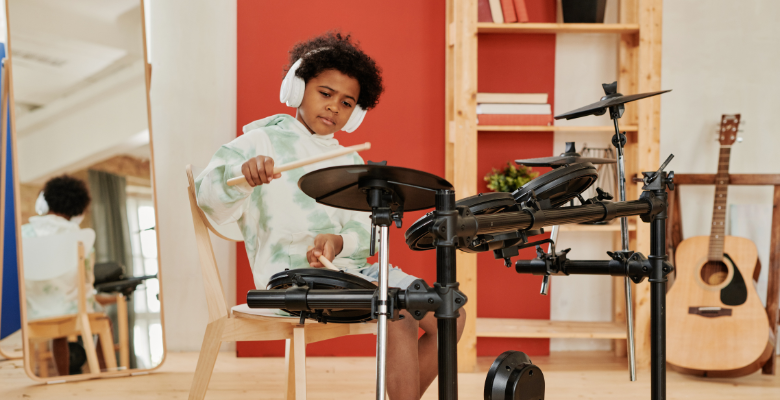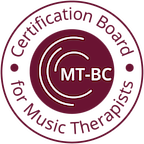As parents and caregivers, it can be quite a challenge to find creative ways to help our children learn and develop new skills. In some situations, traditional methods of learning can be boring and sometimes ineffective for children who have learning or attention challenges. One way to spice up the learning process is through music therapy. In particular, learning drum notation can have numerous benefits for children, including cognitive and motor skills development, creativity, stress relief, and coordination, focus, concentration, and more, making it a valuable tool for anyone looking to improve their cognitive and physical abilities.With the right approach and support, anyone can learn to read and play drum notation, even those who may struggle with sitting still or staying focused.
What Is Drum Notation?
For those who are new to the concept, drum notation is a way of writing down the rhythms and beats of a drumming pattern. It’s a bit like sheet music, but instead of notes, there are symbols and markings that represent different drumming techniques and patterns. The best way to learn drum notation is to start simple. Choose a basic beat that’s easy to understand and break it down into its component parts. Next, take those parts and put them together into a more complex rhythm. This process may take some practice, but with dedication and focus, you’ll soon be playing more complex drum patterns.
How to Learn Drum Notation Through Music Therapy
Learning drum notation can be a challenging yet exciting journey for children. The best approach is to start with the basics and progress gradually. First, you need to get a drum set or a practice pad that your child can comfortably use. Second, introduce them to the rudiments which serve as building blocks for drum playing. You can find free resources online or hire a drum tutor who uses a music therapy-based approach. Here, the tutor will use music, visuals, and kinesthetic activities like playing catch to teach your child how to read music notation. In addition, joining a drum circle or band in your community can provide a great platform for your child to learn and practice.
Need more ideas? Read this blog…. “Drumming up Focus: 30 Music Therapy Activities for Teaching Children with Attention Issues Drum Notation”
Non-Musical Benefits of Learning Drum Notation through Music Therapy
The benefits of learning drum notation go beyond just playing a musical instrument. Drumming can have a positive impact on a child’s mental, emotional, and physical well-being. First, it can help improve cognitive skills such as memory, attention, and problem-solving. Secondly, drumming provides an avenue for creativity and self-expression, giving kids a chance to explore their musical talents. It also serves as an effective stress reliever, helping children to release negative energies and improve their mood. Finally, drumming improves coordination, motor skills, and physical fitness, which are important for overall health. These skills can carry over into other areas of life, such as schoolwork or job tasks.
How to Handle Face-Past Kiddos Who Don’t Want to Sit Down and Learn
As a parent, you know that not every child is enthusiastic about sitting down and learning. Some children can be hyperactive or have short attention spans, making it hard to follow instructions. However, there are many ways to overcome this challenge. First, make drumming sessions fun by integrating games, songs, and visuals to break the monotony. Secondly, set achievable goals and celebrate milestones to motivate your child. Thirdly, don’t be too hard on your child if they make mistakes. Instead, provide constructive feedback and encourage them to keep practicing. Lastly, listen to your child and work with them to find out what motivates them. It could be a particular song or a favorite drummer that inspires them. Additionally, make sure to include plenty of breaks and opportunities for movement. Kids who struggle with sitting still may find it easier to learn when they’re allowed to move around a bit.
Music Therapy and Drumming
The benefits of music therapy are worth exploring for every parent, caregiver, or teacher. Through drumming, children can develop important non-musical skills while having fun and enjoying the rhythmic beats. By learning drum notation, children can tap into their musical abilities and gain a sense of accomplishment. Finally, handling face-past kiddos who don’t want to sit down and learn can be challenging, but it is not impossible. With patience, encouragement, and creativity, you can inspire your child to discover their musical talent and benefit from the power of music therapy.
Music therapy is a powerful tool for children’s development, and learning drum notation is a fun and innovative way to incorporate it into their lives. Through drumming, children can learn valuable skills like patience, resilience, and hard work, which are essential for success in life. If you and your child are frustrated with traditional learning methods, it may be worth investing in a few months of concentrated, individualized, therapeutic intervention to meet your child’s music learning needs to set the stage for success for years to come.



